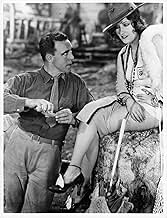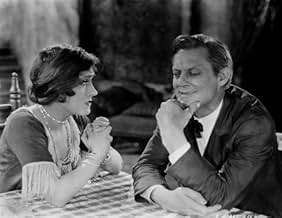NOTE IMDb
7,2/10
2,9 k
MA NOTE
Ajouter une intrigue dans votre langueA prostitute seeking a fresh start becomes the obsession of a religious extremist.A prostitute seeking a fresh start becomes the obsession of a religious extremist.A prostitute seeking a fresh start becomes the obsession of a religious extremist.
- Réalisation
- Scénario
- Casting principal
- Nommé pour 2 Oscars
- 3 victoires et 2 nominations au total
Charles Sullivan
- Marine
- (non crédité)
Avis à la une
Religious hypocrisy is the main theme of 'Sadie Thompson', based on a short story by W. Somerset Maugham. Sharing the same hotel in Pago Pago, a religious reformer (Lionel Barrymore) takes a dim view of a 'loose' woman (Gloria Swanson), and after failing to get her to change her ways, lobbies the local governor to get her shipped back to San Francisco.
I liked this version a bit better than the 1932 version with Walter Huston and Joan Crawford because Barrymore is so brilliant, so harshly upright but at the same time, hinting at a demonic side as he glowers away. Despite the movie being silent, director Raoul Walsh (who also plays Swanson's love interest) delivers a couple of compelling scenes with Barrymore trying to exert his will, Swanson resisting, and the rain coming down, unrelenting. Swanson also lets loose with her anger, and in one funny moment it's obvious she's cursed a blue streak, as the ladies around her cover their ears and scamper off. 1928 was the first year for the Oscars and Swanson would be nominated for her performance. I admire her for it, but admire her more for producing the movie despite pressure because of its content, and considered a slightly higher rating.
The film itself is not in that great a shape, and while the last couple of minutes are mostly gone forever, we're fortunate that Dennis Doros restored it as best possible mostly with carefully selected stills. Watching this one has you clearly thinking you're getting a window into the past, but at the same time, aren't these themes of religious overreach still so prevalent today? Thank you Gloria Swanson.
I liked this version a bit better than the 1932 version with Walter Huston and Joan Crawford because Barrymore is so brilliant, so harshly upright but at the same time, hinting at a demonic side as he glowers away. Despite the movie being silent, director Raoul Walsh (who also plays Swanson's love interest) delivers a couple of compelling scenes with Barrymore trying to exert his will, Swanson resisting, and the rain coming down, unrelenting. Swanson also lets loose with her anger, and in one funny moment it's obvious she's cursed a blue streak, as the ladies around her cover their ears and scamper off. 1928 was the first year for the Oscars and Swanson would be nominated for her performance. I admire her for it, but admire her more for producing the movie despite pressure because of its content, and considered a slightly higher rating.
The film itself is not in that great a shape, and while the last couple of minutes are mostly gone forever, we're fortunate that Dennis Doros restored it as best possible mostly with carefully selected stills. Watching this one has you clearly thinking you're getting a window into the past, but at the same time, aren't these themes of religious overreach still so prevalent today? Thank you Gloria Swanson.
I had only seen Gloria Swanson in her more mature role in Sunset Boulevard and not in her heyday. She is gorgeous downright hot and very convincing as Sadie Thompson. The version of the W. Somerset Maugham story is superior to the better know Joan Crawford version Rain. Lionel Barrymore does a fantastic job as the self serving preacher. Raoul Walsh the well know director appears here as the serviceman who is in love with Sadie.
What a performance - Swanson bursts out of the screen, as Somerset Maugham's prostitute heroine trapped on a tropical island with a crusading parson and a sexy sergeant. And Lionel Barrymore as the parson and the director Raoul Walsh as the sergeant are her match. This is silent acting at its best.
Yes the piece is a little stagey and the action too confined for a silent picture, but when the photography is as brilliant as it is here - who cares? It deservedly won the first ever Oscar for cinematography.
This is a passionate and beautiful production. What a tragedy that the last few minutes have been lost. They have been reconstructed using titles and stills - but how I would have loved to have seen the scene when Barrymore rapes Swanson. It must have been breathtaking. Don't miss this film.
Yes the piece is a little stagey and the action too confined for a silent picture, but when the photography is as brilliant as it is here - who cares? It deservedly won the first ever Oscar for cinematography.
This is a passionate and beautiful production. What a tragedy that the last few minutes have been lost. They have been reconstructed using titles and stills - but how I would have loved to have seen the scene when Barrymore rapes Swanson. It must have been breathtaking. Don't miss this film.
This was the first version of the W. Somerset Maugham novel "Rain," which was remade in 1932 by the original title and again in 1953 as "Miss Sadie Thompson." Gloria Swanson is amazing in the title role as a prostitute who becomes stranded on the remote Island of Pago Pago. She flirts with a soldier (Raoul Walsh, who was the director), then seduces a respected preacher played by Lionel Barrymore. This certainly can be called one of the "pre-code" films of the 1920s/1930s, before the Hays Code was in effect. For many years the final scenes were lost, so now the restored versions use still photos and new title cards to complete the picture.
Unfortunately, the final reel of "Sadie Thompson" has been partially lost due to the ravages of time on nitrate stock. Because of this, the final portion often uses stills to fill in the blanks. It's a less than desirable way to do the film, but there simply is no other choice unless a final reel is one day discovered and the film is pieced back together. In addition, some other portions of the film are pretty rough, but not so much that it seriously impacts watching the film.
I have already seen this story two other times, though this is the first time I've seen the silent version. While it's obvious that Gloria Swanson plays a prostitute (Sadie Thompson), like other films of the day, it's strongly implied but they never called her that or said exactly what she was--just that she was a woman of 'ill-repute' or was 'undesirable'. But, unless you are really, really young or really, really naive, it's very clear what the film is implying in this adaptation of the W. Somerset Maugham story.
The story begins with Sadie arriving on the island of Pago-Pago. On board the ship are also some moralistic reformers, the Davidsons (Lionel Barrymore and Blanche Friderici). Unfortunately for Sadie, these reformers seem to spend almost every waking moment worrying about Sadie's sex life and work hard to have her thrown off the island. At first, Sadie is contemptuous of them but later when it looks like they are about to become successful, things change very quickly. Where all this ends up you'll need to see for yourself.
I liked the acting of this film--especially Swanson's. It was rather bawdy yet very restrained (except for when it called for lots of emotion near the end)--and it easily could have been over the top. Also, although the film's in rough shape, what you do see is quite good--with a good reproduction of the tropical locale and nice camera-work. All in all, a very high quality film from start to finish. Too bad about the missing footage.
By the way, Sadie's ruggedly handsome love interest, Sgt. O'Hara, is played by the film's director, Raoul Walsh! He actually gave up acting for directing full-time after he lost an eye in an accident--shortly after completing this film.
I have already seen this story two other times, though this is the first time I've seen the silent version. While it's obvious that Gloria Swanson plays a prostitute (Sadie Thompson), like other films of the day, it's strongly implied but they never called her that or said exactly what she was--just that she was a woman of 'ill-repute' or was 'undesirable'. But, unless you are really, really young or really, really naive, it's very clear what the film is implying in this adaptation of the W. Somerset Maugham story.
The story begins with Sadie arriving on the island of Pago-Pago. On board the ship are also some moralistic reformers, the Davidsons (Lionel Barrymore and Blanche Friderici). Unfortunately for Sadie, these reformers seem to spend almost every waking moment worrying about Sadie's sex life and work hard to have her thrown off the island. At first, Sadie is contemptuous of them but later when it looks like they are about to become successful, things change very quickly. Where all this ends up you'll need to see for yourself.
I liked the acting of this film--especially Swanson's. It was rather bawdy yet very restrained (except for when it called for lots of emotion near the end)--and it easily could have been over the top. Also, although the film's in rough shape, what you do see is quite good--with a good reproduction of the tropical locale and nice camera-work. All in all, a very high quality film from start to finish. Too bad about the missing footage.
By the way, Sadie's ruggedly handsome love interest, Sgt. O'Hara, is played by the film's director, Raoul Walsh! He actually gave up acting for directing full-time after he lost an eye in an accident--shortly after completing this film.
Le saviez-vous
- AnecdotesUnseen for many years because the last reel had decomposed, the final eight minutes have been reconstructed using production stills and title cards, allowing modern audiences to see an approximation of the complete film.
- GaffesAt the beginning of the film, Mr. and Mrs. Davidson each write a quotation in the ship's autograph book. Their handwriting appears identical, revealing that neither actor actually wrote what is shown on screen.
- Citations
Sadie Thompson: [screaming at Alfred Davidson] Was I doing you any harm? You bloodthirsty buzzard! Was I? Who gave you the right to pass judgement on me? You psalm-singing louse! You'd tear out your own mother's heart, if she didn't agree with you, and call it saving her soul!
- Versions alternativesOriginally released at 97 minutes. Out of circulation for decades because the final reel of the picture was destroyed due to film decay.
- ConnexionsEdited into Spisok korabley (2008)
Meilleurs choix
Connectez-vous pour évaluer et suivre la liste de favoris afin de recevoir des recommandations personnalisées
Détails
- Date de sortie
- Pays d’origine
- Langue
- Aussi connu sous le nom de
- Sadie Thompson
- Lieux de tournage
- Two Harbors, Santa Catalina Island, Channel Islands, Californie, États-Unis(some Pago Pago exteriors)
- Société de production
- Voir plus de crédits d'entreprise sur IMDbPro
Box-office
- Budget
- 650 000 $US (estimé)
- Durée1 heure 37 minutes
- Mixage
- Rapport de forme
- 1.33 : 1
Contribuer à cette page
Suggérer une modification ou ajouter du contenu manquant

Lacune principale
By what name was Faiblesse humaine (1928) officially released in Canada in English?
Répondre



























